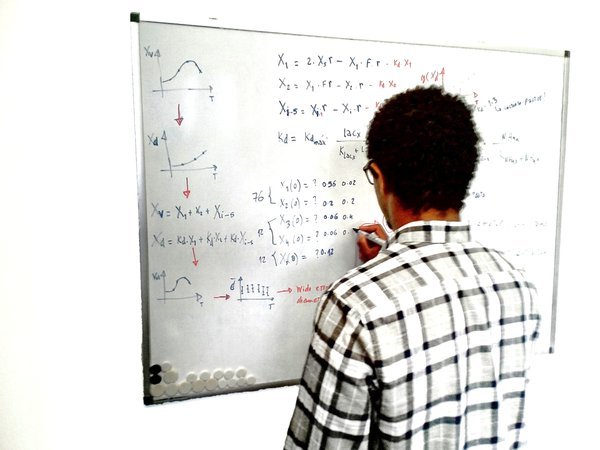
Dynamics of Glycolysis and Citric Acid Cycle in Mammalian Cells
Motivation
Animal cell lines are widely used in various processes for the production of high value biopharmaceuticals, i.e. recombinant proteins or viral antigens [6]. Often the yield of these post-translational modified proteins is comparatively low. Accordingly, process development and cell lines optimization are of considerable interest. Typically, cell line optimization relies on the studies of the cellular metabolism and especially on the dynamics of glycolysis and citric acid cycle as central pathways of energy and carbon metabolism. In bacteria and yeast, for example, cell line optimization using a combination of experimental and mathematical approaches to study metabolism enabled a significant improvement of many biotechnological processes.
In contrast, improvement of animal cells relying on studies of metabolism on a system level is still a significant challenge. Compartmentalization as well as many changes in reactions and control of metabolic pathways due to the immortalization of production cell lines, complicates this task. Additionally, not much experimental data regarding the dynamics of intracellular metabolite concentrations and enzyme activities of production cell lines used in biotechnological processes are available.
![Central carbon metabolism of adherently growing Madin Darby Canine Kidney cells used for influenza vaccine production (modified from Wahl et. al., 2008) [3]. Some reactions were lumped; green: measured metabolite concentrations (Ritter et. al. 2006) [4]; blue: measured in vitro enzyme activities (Janke et. al. 2010) [2]](/3368248/original-1518440815.jpg?t=eyJ3aWR0aCI6MjQ2LCJvYmpfaWQiOjMzNjgyNDh9--3818d2d238fe77975f7bb1cc508d9cd26dde18fb)
Quantitative models
To improve our understanding of the highly complex carbon and energy metabolism of animal cells a combination of mathematical approaches and experimental methods from the field of systems biology are required. To perform a systems analysis of the metabolism of cells, the development of a validated quantitative mathematical model is central. One model, which was established recently by Rehberg et al. for adherent Madin Darby Canine Kidney (MDCK) cells [2], is based on differential algebraic equations, and balances the amount of each metabolite in the reaction sequence of the corresponding pathway. The derived model was validated against time resolved data of more than 30 intracellular metabolites, including organic acids, sugar phosphates and nucleotides (Project: Quantitative Analysis of Energy Metabolism of Animal Cells). Furthermore, this segregated model used in vitro enzyme activities measured for MDCK cells by our group (Project: Enzymatic Characterization of Mammalian Cells) [1].
Aim of the project
The current focus of this project is the adaptation of the models established by Rehberg et al. [1] to describe cultivations of suspension cells such as MDCK_SUS2 or AGE1.HN.ATT (a human designer cell line). The performance of the models will be assessed with data (extracellular and intracellular metabolite concentrations, enzyme activities) collected during various batch experiments performed by our group [5]. Furthermore, the models will be validated using data obtained from substrate limitation experiments. Based on a validated model, we will design new experiments to gain further insight into the regulation of pathways and enzymes under various cultivations conditions. For MDCK_SUS2 cells, in addition, the model will be used to study the impact of viral replication on the intracellular metabolism. Overall, this work will contribute to the identification of process parameters relevant for increasing specific productivity of animal cell lines, and the optimization of related biopharmaceutical processes.
![Central carbon metabolism of adherently growing Madin Darby Canine Kidney cells used for influenza vaccine production (modified from Wahl et. al., 2008) [3]. Some reactions were lumped; green: measured metabolite concentrations (Ritter et. al. 2006) [4]; blue: measured in vitro enzyme activities (Janke et. al. 2010) [2] Central carbon metabolism of adherently growing Madin Darby Canine Kidney cells used for influenza vaccine production (modified from Wahl et. al., 2008) [3]. Some reactions were lumped; green: measured metabolite concentrations (Ritter et. al. 2006) [4]; blue: measured in vitro enzyme activities (Janke et. al. 2010) [2]](/3368248/original-1518440815.jpg?t=eyJ3aWR0aCI6MzQxLCJmaWxlX2V4dGVuc2lvbiI6ImpwZyIsIm9ial9pZCI6MzM2ODI0OH0%3D--f5b3078ba8d43ca5844c1a43bf6358f008aa3a3c)
